Unique plants can make your home look better! If you are looking for low-maintenance options, here are the Best Indoor Succulents!
Indoor plants are the best way to invite positive vibes to the home, and what could be better than the ones that are easy to maintain and also look wonderful? Here are the Best Indoor Succulents that you must grow!
Best Indoor Succulents
1. Burro’s Tail 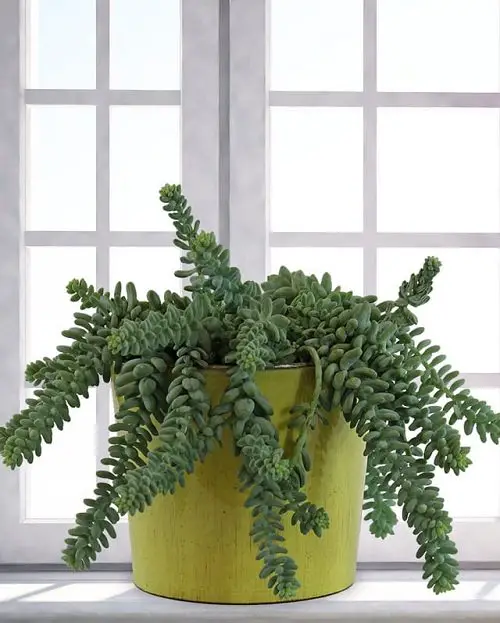
Botanical Name: Sedum morganianum
Native to Mexico, Burro’s tail is best planted in hanging baskets due to its plumped trailing stems. The beautiful gray-blue or gray-green leaves can grow up to 2 feet long. This plant does best when kept in a spot that receives bright sun.
Growing Tips
- Let the soil dry out between watering spells, and ensure that soil is kept on the dry side in times of winter dormancy, especially if you’re growing it in a cool-temperate zone.
- Fertilize the plant once in summer using a 10:10:10 fertilizer or cactus fertilizer.
- Leaves will fall off with the slightest of touches, so it is important the plant is placed where there will be minimal disturbance.
- If you have to move it outside for the summer sun, ensure it will acclimate well before keeping it in full sun.
2. Zebra Cactus
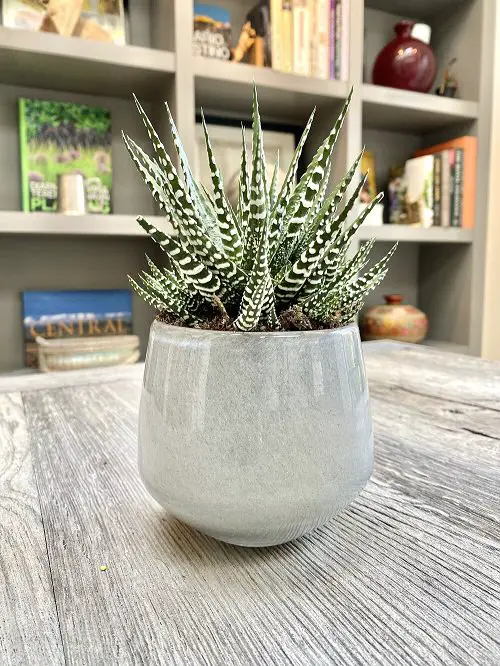
Botanical Name: Haworthia fasciata
The Zebra Cactus is known for its striking appearance. It features white horizontal stripes on its dark green skin. This succulent thrives in well-drained soil and requires minimal water. Its unique pattern and low-maintenance nature make it a popular choice for indoor gardening.
Growing Tips
- Use a shallow pot since the roots don’t penetrate the soil deeply.
- Re-pot it at 12-24 months with the fresh succulent potting mix for optimum growth.
- Allow the soils to dry out nearly between watering spells. It’s important for all the succulents.
- The zebra plant is best placed in a bright spot so as not to expose the plant to the direct sun lest it becomes shriveled.
Here are Eye-Catching Houseplants with Zebra Prints
3. Aloe Vera
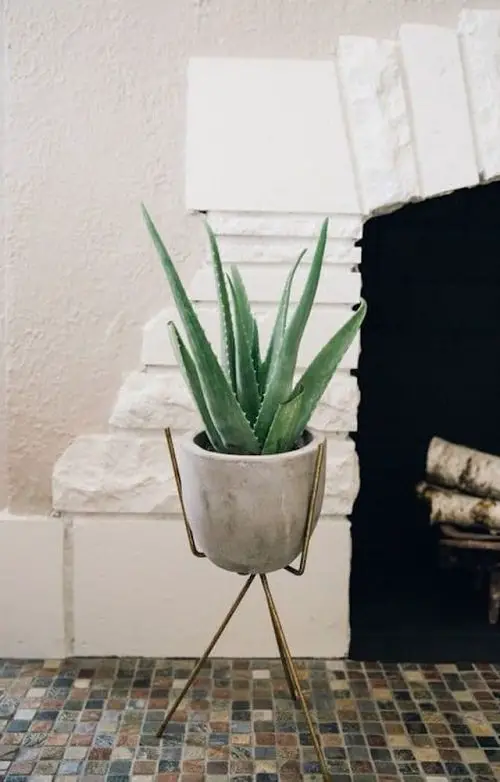
Botanical Name: Aloe barbadensis miller
Aloe vera is a medicinal plant; the sap of this succulent has been used to treat sunburn and wounds for centuries. Apart from this, aloe vera is also a great indoor plant as it purifies the air too.
Growing Tips
- Let the soil dry between soakings.
- Put it where it can get a couple of hours of sunlight daily.
- Fertilize the plant twice during the growing season using a balanced 10:10:10 fertilizer, but don’t fertilize in winter.
- Do not repot unless the roots start to push their way out of the pot.
4. Crown of Thorns

Botanical Name: Euphorbia milii
Native to Madagascar, this plant can bloom throughout the year if it receives enough light. The long and spoon-shaped leaves appear at the end of its spiky branches, together with tiny flowers.
The flowers are not noticeable because of their small size, but you will see yellow, red, or salmon bracts surrounding them that look attractive.
Growing Tips
- This plant has low to moderate watering needs.
- Avoid letting the whole pot dry out, or it will drop leaves.
- Direct light will give you the best bloom, although the plant can adapt to medium-light conditions.
- Fertilize 2-3 times with a balanced 10:10:10 fertilizer during the growing season.
5. Hens-and-Chicks
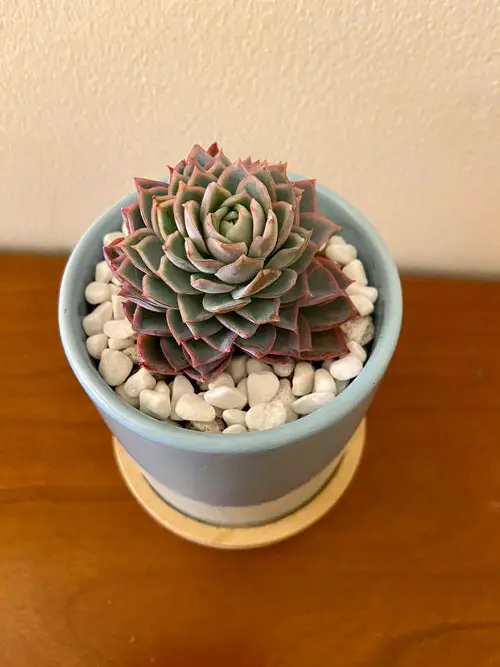
Botanical Name: Sempervivum tectorum
The Hens-and-Chick plants are another great succulent group of plants for indoor gardening; they form flat flowerlike rosettes that have rounded edges.
These plants need to be allowed to dry a bit between watering since overwatering can cause rotting.
Growing Tips
- Water very infrequently during winter dormancy if growing in a cooler region.
- Keep these plants in a bright spot; they can also tolerate light shade.
- You can propagate the plants by cuttings.
6. String of Bananas
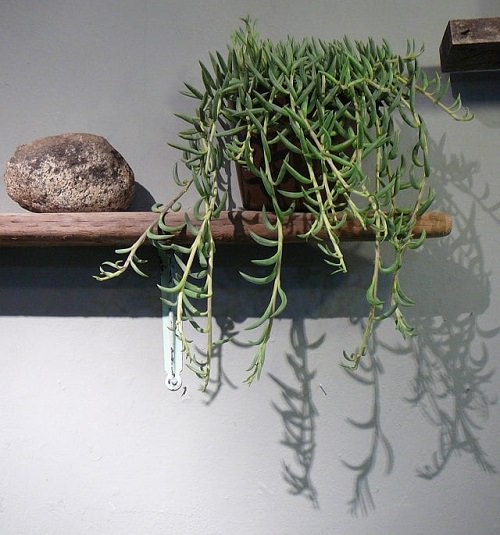
Botanical Name: Senecio radicans
The trailing indoor succulent plant produces long tendrils of small banana-like leaves. The plant looks great when planted on its own and should be pruned regularly to grow thick and full. It also works beautifully in a pot containing other succulent indoor plants.
Growing Tips
- It requires filtered sunlight
- Water the plant when the soil is dry to touch
- It does well in porous soil with excellent drainage.
- It is toxic, so you must keep it away from pets and children who might munch it.
Take a look at the Best String Succulents that Hang
7. Lithops

Botanical Name: Lithops
Lithops are unique small and inconspicuous succulent plants that look like stones or pebbles. Growing lithops is very easy and doesn’t require much care.
Growing Tips
- Keep the plant in a sunny location; a south or west-facing window would be best, away from drafts.
- Grow lithops in poor, well-drained soil.
- Stop watering your lithops plants in winter (in cooler zones).
8. Christmas Cactus

Botanical Name: Schlumbergera x buckleyi
Christmas cactus needs no introduction; it is one of the most beautiful succulent plants, and it looks good even without flowers.
Growing Tips
- For this plant to grow, allow the top 2 inches of the soil to dry between watering spells.
- Keep the plant on the dry side during winter. When it is in the bud stage, be very careful since even the slightest overwatering or dehydration can lead to buds dropping.
9. Ponytail palm

Botanical Name: Beaucarnea recurvata
A Ponytail palm is not a palm but a succulent. Probably one of the most appealing houseplants and the best in large houseplants. Its water is stored in the swollen stem base, which looks like an elephant’s foot; that’s why it’s also called “Elephant Foot Palm.”
Growing Tips
- It grows well in sunny spots but can be grown in all day long, with bright indirect sunlight.
- It’s a plant-and-forget kind of plant when it comes to watering. Avoid watering regularly and let the top soil dry out before watering again.
10. Snake Plant

Botanical Name: Dracaena trifasciata
The snake plant or Mother-in-law’s tongue is the most low-maintenance plant in this list of best succulent indoor plants, and it is well-deserved!
We also listed it in our post– Plants You Can Grow without Sunlight. And why not? This succulent plant can survive in the darkest of corners and requires very low maintenance.
Growing Tips
- Water moderately.
- As the snake plant is a very forgiving plant, you can place it in dim spots.
11. String of Pearls
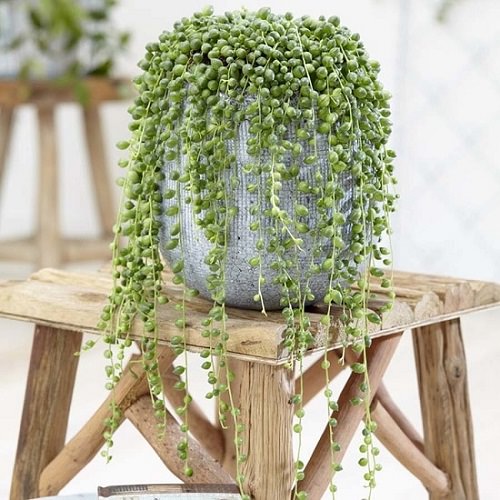
Botanical Name: Senecio rowleyanus
The string of pearls is an outstanding trailing houseplant, indoors when grown in hanging baskets. You can experiment to grow it in different containers. Like other succulent houseplants, growing a string of pearls or beads is no different.
Growing Tips
- Keep the string of pearl plants in a bright light.
- Be careful with watering; this plant has low watering needs, but in warmer regions, moderate watering is required.
Here are the best trailing succulents you can grow
12. Panda Plant
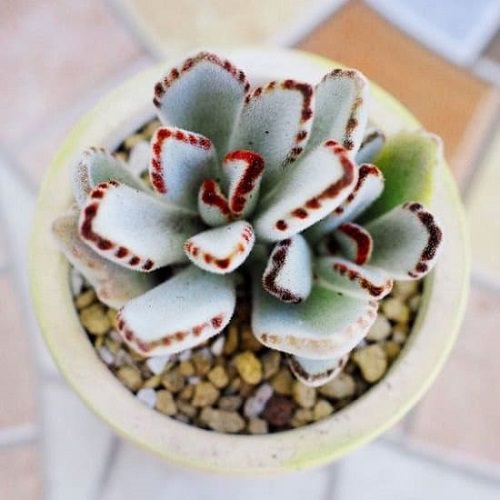
Botanical Name: Kalanchoe tomentosa
The silver gray hair of this plant makes it look fuzzy, and the leaves are plump like other succulents and have rusty color on the edges; like many other plants of the Kalanchoe genus, the plant forms flowers, too. However, they rarely bloom in indoor conditions.
Growing Tips
- Keeping the panda plant in a spot that receives bright indirect light and a couple of hours of direct sunlight is a good idea.
- Water infrequently and let the plant dry out between the watering spells.
- Feed the plant once a month during the growing season.
- Save the plant from cold and draft; normal room temperature is perfect.
13. Kalanchoe
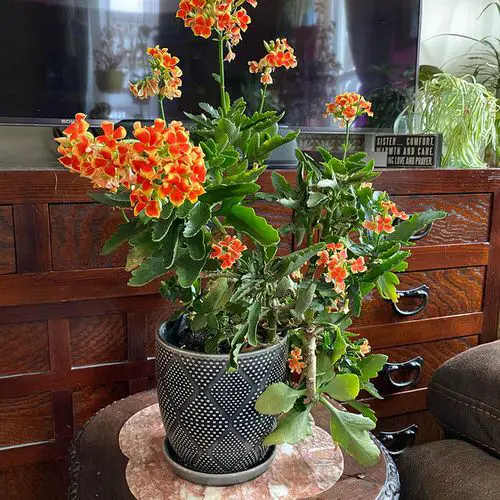
Botanical Name: Kalanchoe blossfeldiana
Kalanchoe blossfeldiana is one of the best flowering houseplants you can grow. Plants of this genus grow best outdoors in warm climates. However, it can be grown indoors. This flowering succulent comes in a variety of colors.
Growing Tips
- Low watering needs.
- The plant needs to be in a sunny spot to bloom.
14. Pencil Cactus
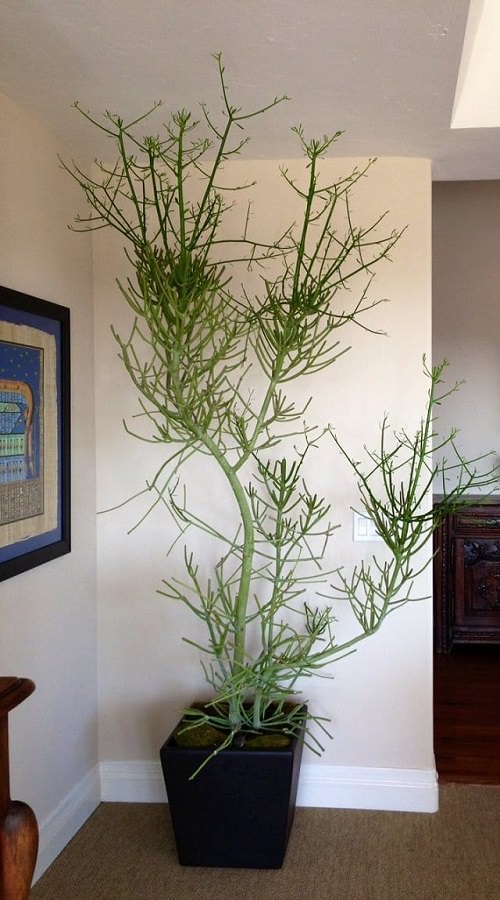
Botanical Name: Euphorbia tirucalli
Pencil cactus has become one of the most popular succulent houseplants in the last few years, and why not? This unique African plant can grow up to 6 feet tall indoors and looks so different; quite a few houseplants like fiddle leaf fig can achieve such height.
Growing Tips
- Keep the plant near a sunny window.
- Water every couple of weeks; the plant has low watering needs.
- Use well-drained, gritty soil.
- Repot the plant every year or when you find it rootbound.
Learn How to Grow Pencil Cactus
15. African Milk Tree

Botanical Name: Euphorbia trigona
The African Milk Tree shows off triangular stems that have ridges with thorn and teardrop-shaped leaves. This perennial can grow up to 6-9 feet tall and 1-2 feet wide.
Growing Tips
- Water it 2-4 times per month or when the topsoil becomes dry.
- A location with indirect light or partial shade will be ideal for this succulent.
16. Bear Paws

Botanical Name: Cotyledon tomentosa
The bear paw succulent is an ideal choice for indoor gardens; it features thick, fuzzy leaves with dark red margins that resemble bear claws. It can reach up to 1 foot tall.
Growing Tips
- Water the plant when 1-2 inches of topsoil become dry.
- Keep it where it gets full sun to partial shade.
17. Devil’s Backbone
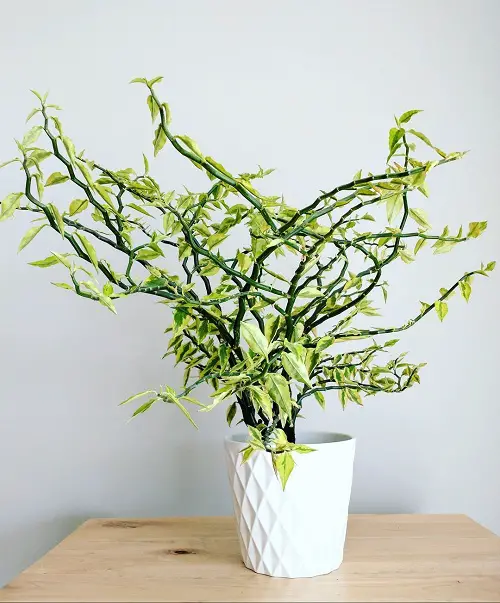
Botanical Name: Euphorbia tithymaloides
Native to northern climates in parts of Africa and Central America, this popular tropical succulent is perfect for indoor gardens. This slow-growing succulent shows off white and green variegated leaves on wavy stems. It grows up to 2-3 feet tall.
Growing Tips
- Keep it where it gets bright, with the indirect sun to partial shade.
- When the top 1-2 inches of soil turn dry.
18. Happy Bean
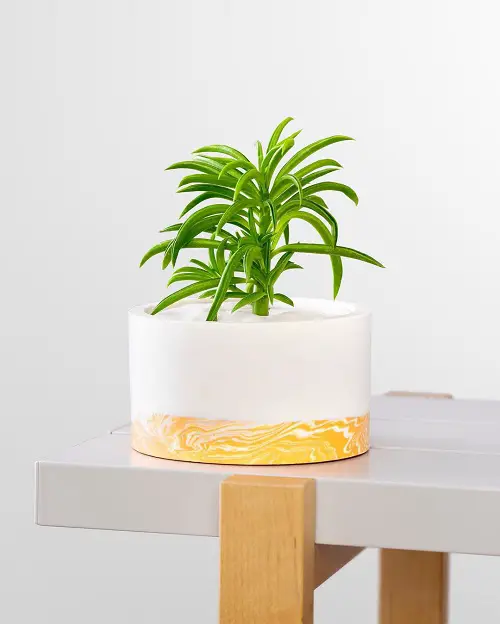
Botanical Name: Peperomia ferreyrae
Also known as Pincushion Peperomia, it offers bushy curved leaves. This succulent can reach up to 8 inches tall with the same spread.
Growing Tips
- Full sun to partial shade is ideal for this plant.
- Water the plant when the top 1-2 inches turn dry.
Here are the best Echeverias that grow bigger and fuller
19. Ogre Ears Succulent

Botanical Name: Crassula ovata ‘Ogre’s Ears’
‘Ogre’s Ears’ features slightly fluted or undulated bright green leaves that turn red with drought or cold. The size of the plant varies by species.
Growing Tips
- Water this drought-tolerant plant when the top 1-2 inches of the soil turn dry.
- Full sun to partial shade is ideal for this succulent.
20. Ox Tongue 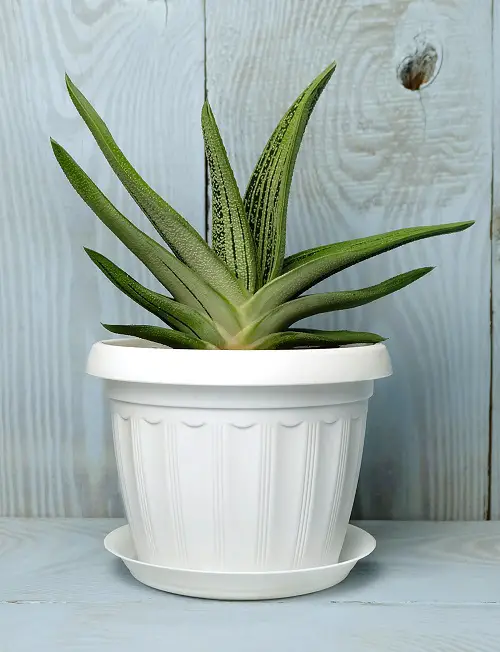
Botanical Name: Gasteria spp.
This perennial succulent grows up to 4-24 inches tall and 12 inches wide; it displays long, rough-textured leaves and some species have patterns on the leaves.
Growing Tips
- Full sun to partial shade.
- Water when topsoil turns dry up to 1-2 inches.
21. Pinwheel Desert Rose
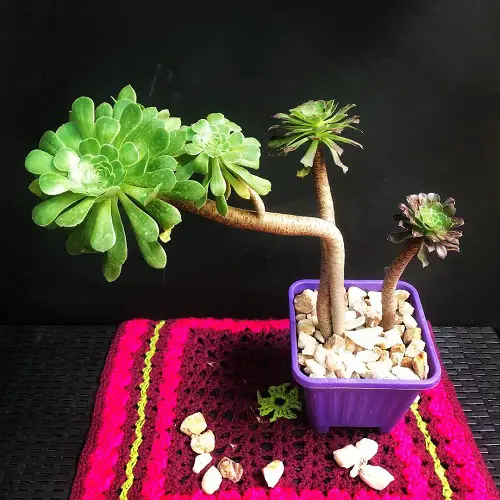
Botanical Name: Aeonium arboreum
Also known as Black Rose Tree Houseleek, this perennial succulent exhibits fleshy rosette in a solid color or variegated in green, yellow, white, or red.
Growing Tips
- It can flourish in most light settings, including partial shade.
- Water when the top 1-2 inches of soil turn dry.
Learn everything about Desert Rose Care
22. Wax Flower

Botanical Name: Hoya carnosa
This perennial succulent grows up to 12-20 feet long and offers small, waxy twisted leaves and scented colorful blooms.
Growing Tips
- Keep it where it gets indirect sun.
- Water when the top 1-2 inches of the soil turn dry.
23. ZZ Plants

Botanical Name: Zamioculcas zamiifolia
This low-maintenance succulent is a good choice for indoor gardens; it displays deep green glossy leaves. The plant grows up to 3-4 feet tall.
Growing Tips
- Place the plant where it gets low, indirect light, or partial shade.
- Water when the topsoil becomes dry.
24. Moon Cactus
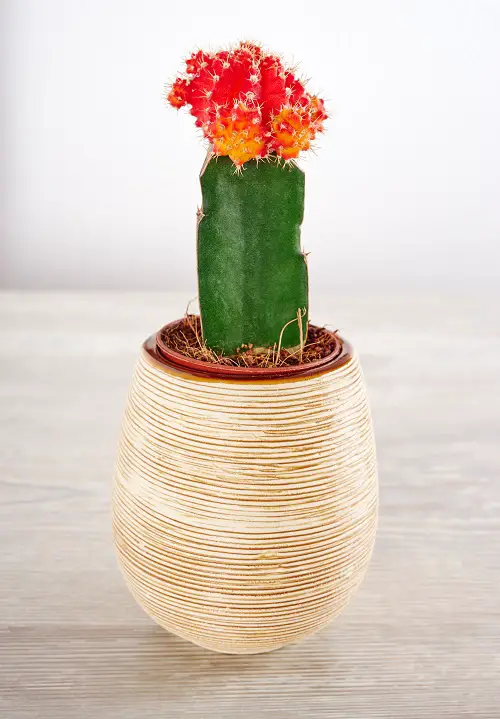
Botanical Name: Gymnocalycium mihanovichii
This beautiful cactus displays bright red, yellow, and orange round tops, known as scions, over green rootstock. It needs a dry spell before heavy watering.
Growing Tips
- The green rootstock needs a lot of sunlight, so place it near a bright, indirect, sunny window.
- Keep it in an area where it receives some indirect light, but don’t expose it to direct sunlight for more than 2 hours daily as color may fade.



Pencil Cactus exude a white sap that can be lethal to pets and small children and can blind a person if they rub their eyes after getting the sap on his/her hands.
Wow, Thanks for informing .
Thanks for that advice!!
The sap of the pencil cactus is as dangerous as lye. It causes severe burns and it cannot be rinsed off early and must be removed with a solvent. If you accidentally were to rub your eyes your corneas would be burned and you would go blind. This is not speculating it has happened. It should not be sold as a houseplant.
Great article. Idk why but snake plant has always been my favorite. But I read somewhere that they’re poisonous to pets. Is it really true?
Do other Snake plants do well indoors? Like Draecena ‘Moonshine’?
Your suggestions are always matters to me. Specially when we talk about best indoor gardening stuff.
Thanks for this article.
The same applies to Crown of Thorns – Euphorbia millii. All Euphorbias contain a milky sap that is caustic in various degrees. In some species this sap is under pressure so if you (or a grazing animal) break a bit off it can spit out at you. A very interesting group of plants with many kinds but best kept outside I’d say.
Very good info! I’m excited to start a succulent garden.